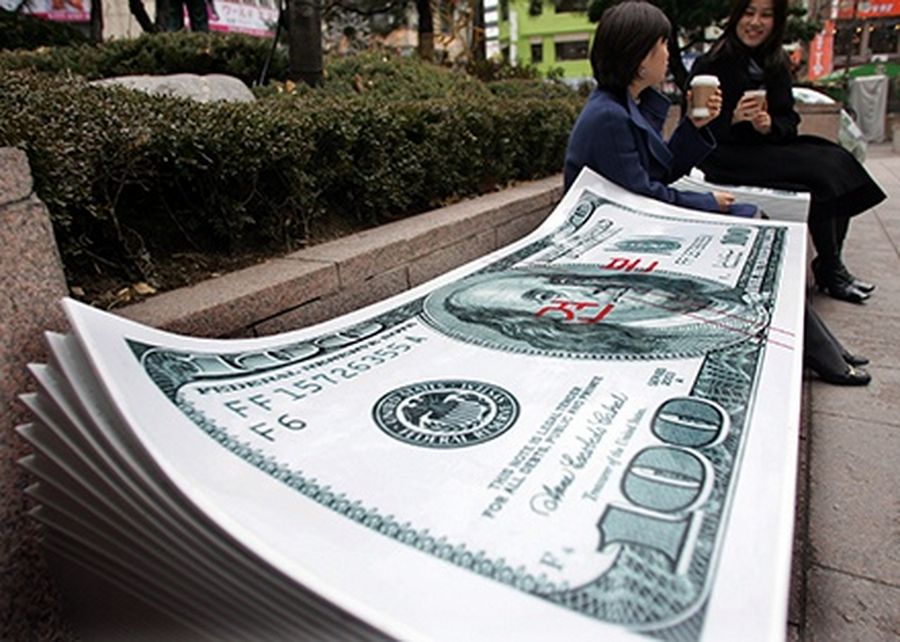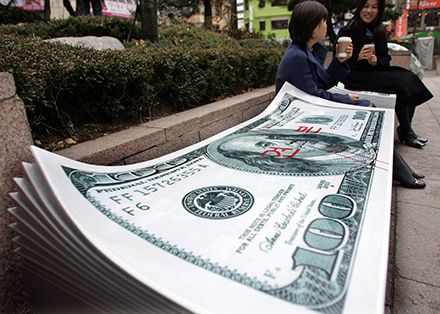The reaction to the US Federal Reserve’s first mention of “tapering” roiled Asian financial markets last year, underlining the region’s vulnerability to global monetary policies. Still, even with a slowdown in China looming, Asia is stronger today than when the financial crisis hit in 1997.

Capital support
Source: REUTERS/Kim Kyung-Hoon
South Korean women sit on a bench in the shape of the 100 dollar U.S. bank note in front of Korea Exchange Bank in Seoul.
Asia’s capital markets were caught off guard late last May, when US Federal Reserve Chairman Ben Bernanke first floated the idea of a gradual reduction to the US monetary stimulus. Investors had been buying assets across the region, related prices were high and confidence was strong.
Stock indices in Jakarta and Manila were at all-time peaks and Thailand’s SETI was at its highest since 1994. The correction that followed over the next three months was brutal, as risk assets and currencies came under attack in a global flight to safety. Jakarta shares slumped 24%, Indonesia’s rupiah lost 12% against the dollar and the Indian rupee skidded 22%.
When tapering finally began in December, markets reacted far more calmly. While many of the most oversold markets have since staged something of a recovery, the potential for another knee-jerk reaction remains a threat.
“The selloff of 2013 is a warning sign for what could happen to Asia when the US does apply the brakes and the Fed raises rates,” said Frederic Neumann, head of Asian economic research at HSBC.
After last summer’s sudden correction, US Treasury rates have ratcheted gradually higher and most analysts believe tapering is fully priced in. There is, however, plenty of room for nasty surprises. The five-year Treasury yield jumped 15bp on March 19, the day new Federal Reserve Chair Janet Yellen said the first hike in US policy rates could come as soon as six months after the tapering programme was completed.
“The lack of infrastructure is becoming a serious hurdle to growth. Emerging Asia has huge infrastructure needs, but struggles to complete projects because of bureaucracy, capacity or a lack of available financing.”
For Asia, this series of events underlines the region’s dependence on global capital flows. Having ridden a wave of enthusiasm for emerging markets, and years of ultra-low fixed-income rates, Asia’s economies and markets again look much more vulnerable.
“While risks have generally subsided for the time being, flatter economic growth and potential financial markets volatility resulting from any quantitative-easing tapering make for some potential credit headwinds for Asia-Pacific issuers,” Andrew Palmer, a credit analyst at Standard & Poor’s, said in March.
Asian economies can improve their finances and deepen their domestic markets to enhance their chances of withstanding any volatility.
“Capital flows should be seen as a temporary shock, and not a permanent capital injection,” said Joseph Zveglich, assistant chief economist at the Asian Development Bank in Manila. “Countries need to put in place prudent macroeconomic policies. Reforms are key.”
Stronger than 1997
There is no need to panic, however. Asia is in a far stronger position than it was in 1997, when extensive overseas borrowing left the region sorely exposed to global capital flight. Local markets are deeper and safety nets are in place, such as the Chiang Mai Initiative Multilateralisation, a US$240bn network of currency-swap agreements between the ASEAN countries, Japan, South Korea, China and Hong Kong.
“Asia is not as exposed as it was in 1997,” said Zveglich. “The region’s reserve coverage is much better: short-term debt to reserves was 100% in 1997, and less than 50% now.”
Improved regional economics did little to help either Indonesia or India in 2013, when the two countries bore the brunt of heavy selling from global emerging-market funds. Investors, perhaps fearful of another balance-of-payments crisis, cut their exposures to currencies where national finances were weakest. The rupiah and rupee quickly came under attack.
Still, even against such a strong global headwind, those countries were able to avoid a crisis.
“It is a bit unfair that Indonesia and India, where the ratios of total credit to GDP has remained almost flat since 2008, were dragged down in the currency markets, but the local systems digested the turmoil quite well,” said HSBC’s Neumann. “They are not completely out of the woods, but there was no balance-of-payments crisis and the rupiah this year has come back quite well.”
Rising sun
Neumann noted that Asia also stood to benefit from Japan’s massive monetary easing, even if the US was withdrawing its own stimulus. The Bank of Japan’s efforts to stimulate inflation – the first of three arrows under Prime Minister Shinzo Abe’s reform plans – acted, to some extent, as a “counterweight” against rising US dollar rates, he said.
Japanese banks were once again the world’s biggest cross-border lenders, the Bank for International Settlements said in September, noting that overseas loans had risen to about 13% of all international claims as of March 2013.
Japanese loans outstanding in China, Hong Kong and Singapore at the end of September were at their highest since at least 2010, BIS data showed.
The bank also reported that international claims on Japanese banks jumped 10% in the third quarter of 2013 to US$313.8bn, suggesting that international enthusiasm for Japan’s reforms was amplifying the impact of Abenomics and playing a greater role in fuelling Japanese credit growth.
Japanese companies, particularly financial institutions, have been especially busy in buying assets overseas, especially in South-East Asia. Mitsubishi UFJ Financial Group took a majority stake in Thailand’s Bank of Ayudhya for US$5.6bn last year, while Sumitomo Mitsui Banking Corp agreed to buy 40% of Indonesia’s Bank Tabungan Pensiunan Nasional last May for Rp13tn ($1.3bn).
“There is some evidence that Japan’s actions are having an impact, particularly on ASEAN. M&A into ASEAN hit a record in 2013 and FDI soared back,” said Neumann. “To some extent, it is a stabilising force against rising US dollar rates, a counterweight at least for the time being.”
Japanese investors, however, remain a conservative group and hopes that a greater proportion will shift their attention away from low-yielding government bonds have so far not been realised. Equity markets, which had surged in 2013 on higher growth expectations, have slipped this year as doubts emerge over Abe’s fiscal and structural reforms.
In April 1, Japan hiked its consumption tax to 8% from 6% to show its commitment to fiscal responsibility. Many analysts are concerned the added household burden will derail efforts to stimulate consumer spending.
Yasutoshi Nishimura, senior vice minister of the cabinet office, told delegates at Credit Suisse’s Asian Investment Conference in March the government was “very confident” that an average wage increase of 2.2%, a childcare subsidy to encourage more women into the workforce and a series of one-off budget measures would offset the impact of the tax hike. The changes in Japan represented a “once-in-decades” opportunity for international investors, he said.
Not everyone is so convinced. While an expanding Japan would have obvious benefits for Asia, analysts and politicians note that 15 years of deflation underline the challenge of introducing the reforms needed to reinvigorate the economy.
“The third arrow is aiming at the right target, but lacks the strength to reach that target so far,” said Yoshihiko Noda, former prime minister and member of the opposition, speaking through an interpreter at the same Credit Suisse event.
“The reforms need much more depth, and we know that many stakeholders and lobby groups are very resilient against change. This is a true test for the government,” Noda said.
Zveglich at the ADB agrees that the third arrow of Abe’s economic plan – structural reform – is more important than the BOJ’s monetary expansion.
“Japan is reaching a critical point. It is not possible to stimulate the economy through constantly injecting money, so the third arrow is crucial. The pace of translating that into policy is key,” Zveglich said. “If it helps Japan grow, there will be benefits for the region in general.”
Still work to be done
Asia, of course, can neither rely on Japan’s reforms alone to ensure its own growth continues nor assume US portfolio flows will remain stable. The region must also put in place measures to boost efficiency and reduce infrastructure bottlenecks, says Neumann at HSBC.
“Asia has relied for too long on debt to generate growth, while productivity growth has been slowing since 2007,” said Neumann.
“The lack of infrastructure is becoming a serious hurdle to growth. Emerging Asia has huge infrastructure needs, but struggles to complete projects because of bureaucracy, capacity or a lack of available financing.”
Markets have focused, in particular, on China, where important long-term reforms risk slowing an economy crucial for many other countries in Asia. China is taking steps to improve its productivity through the reform of state-owned enterprises and dismantling of state monopolies, as well as the internationalisation of the currency, and greater transparency and efficiency in its capital markets.
Those efforts come at a critical juncture, as slow worldwide growth risks magnifying the impact of any slowdown in the Chinese economy. Historically, every 1% GDP decline in China has resulted in a 0.6% slowdown in ASEAN GDP, notes the ADB’s Zveglich.
“China recognises the need to shift to a slower growth trajectory. We are probably looking at 7%–8% over the next five years,” he said. “Reforms will mean more domestic demand for Asian goods, but the rebalancing of China’s economy will take time.”
While a slower, rebalanced Chinese economy will benefit Asia ultimately, the reform process itself involves considerable risks.
In particular, the first default in China’s domestic bond market in early March, when Shanghai Chaori Solar Science & Technology missed a coupon payment, highlights concerns of a debt crisis as the economy slows.
Default protection costs for overseas Chinese bonds rose in the first quarter of 2014, but domestic yields have remained relatively stable despite the rising concerns.
HSBC’s Neumann says China poses a number of risks for Asia, but believes financial turmoil in China is unlikely in the near term.
“The default is a rounding error. If China grows at 7.5%, it is still adding twice the size of the Malaysian economy each year,” he said.
Deutsche Bank chief economist Taimur Baig is also in the bullish camp.
“The Chinese authorities have the capacity to manage financial sector and governance-related risks without creating panic or dysfunction,” he wrote to clients in late March. “There is no question that the central government can finance a bailout of highly leveraged entities.”
Risks ahead
The ADB raised its forecast for Asian growth in its latest Asian Development Outlook report in early April, noting that risks to the region from US tapering had eased. The bank said it expected the region to grow 6.2% this year, slightly faster than its most recent estimate of 6.0% in December, before accelerating further to 6.4% in 2015.
“Most regional economies have strengthened their economic fundamentals. Looking ahead, strengthening macro-prudential measures before the boom can help avert sudden capital reversals that accompany the bust,” the ADB said.
Neumann at HSBC warns that complacency brings with it other dangers, arguing that Asia still needs to do more to strengthen its defences.
“Asia is facing a dilemma. The writing is on the wall for US interest rates, but the BOJ has bought some time,” he said. “There is no pressure on policymakers to do anything.”
For Zveglich, meanwhile, the biggest risk for Asian development lies not in financial markets, but in something potentially far more worrying.
“The biggest risk to growth right now is global politics,” he said. “There are a number of situations that could weaken trade and could easily undermine what is a very fragile recovery.”
To see the digital version of this report, please click here.
